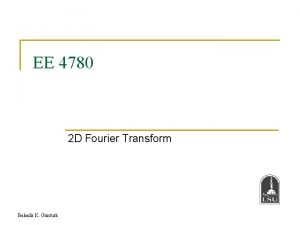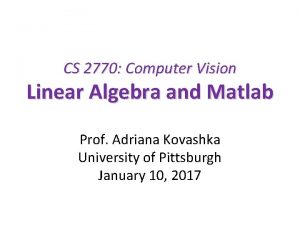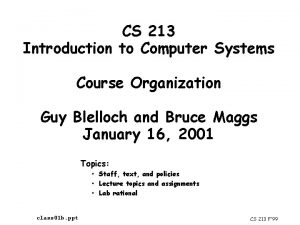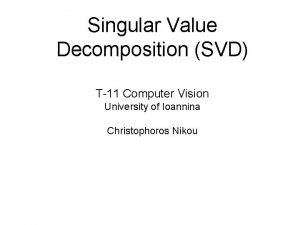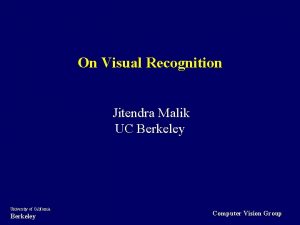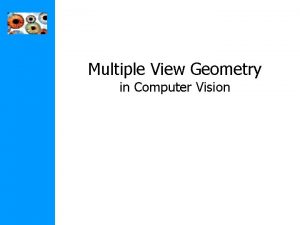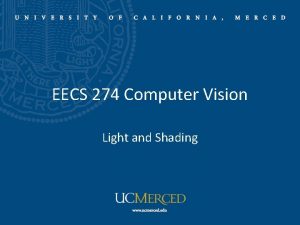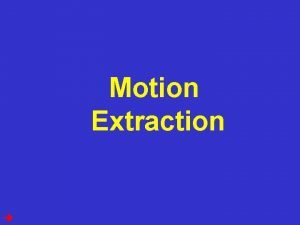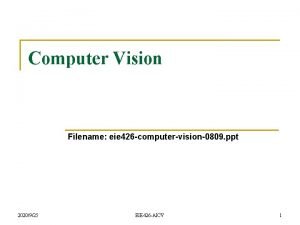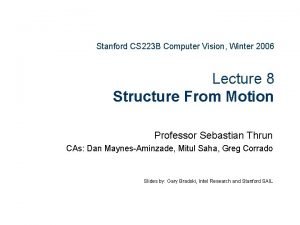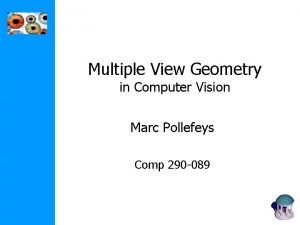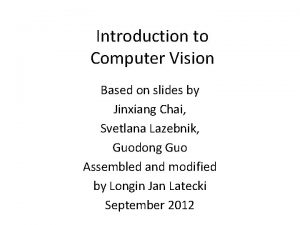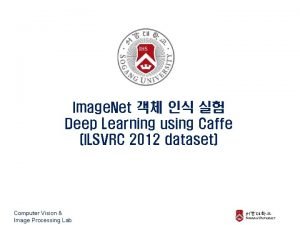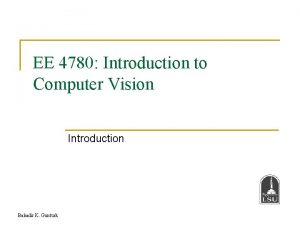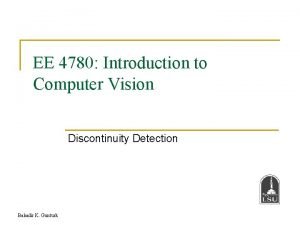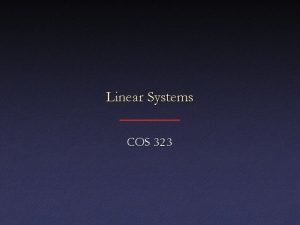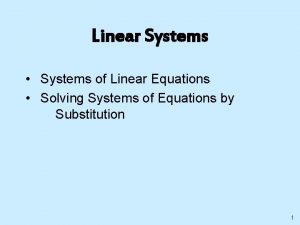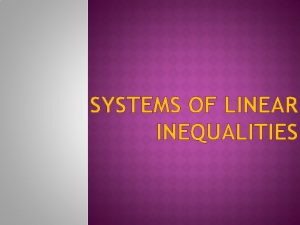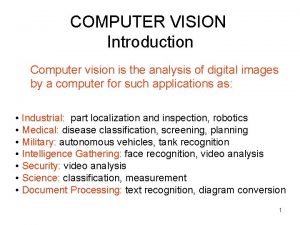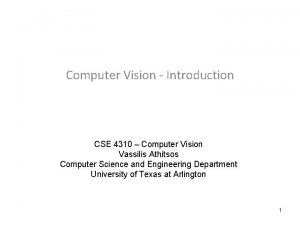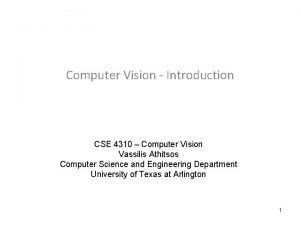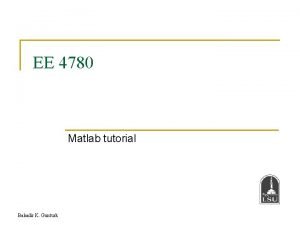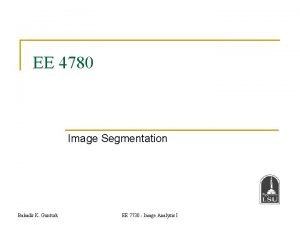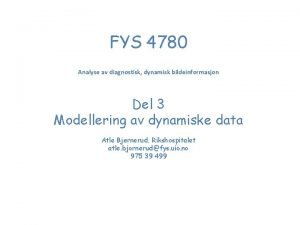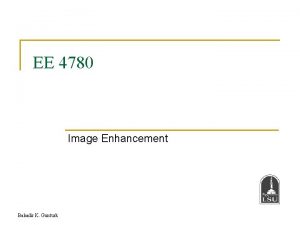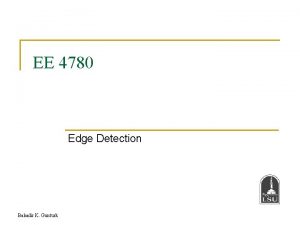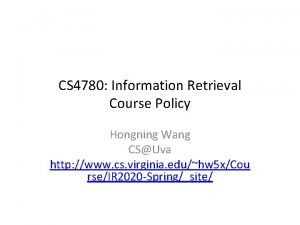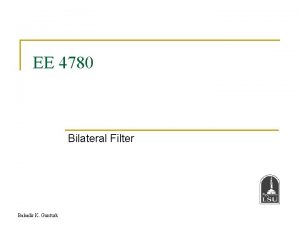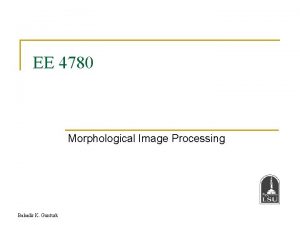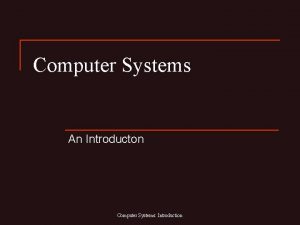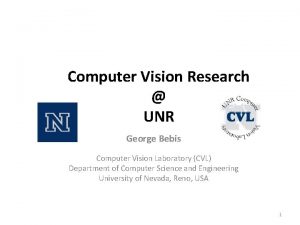EE 4780 Introduction to Computer Vision Linear Systems




















![Try MATLAB f=imread(‘saturn. tif’); figure; imshow(f); [height, width]=size(f); f 2=f(1: height/2, 1: width/2); figure; Try MATLAB f=imread(‘saturn. tif’); figure; imshow(f); [height, width]=size(f); f 2=f(1: height/2, 1: width/2); figure;](https://slidetodoc.com/presentation_image_h/1d85f425f119cf5842fba983dbbdbdc9/image-21.jpg)


- Slides: 23

EE 4780: Introduction to Computer Vision Linear Systems Bahadir K. Gunturk

Review: Linear Systems n We define a system as a unit that converts an input function into an output function. Independent System operator variable Bahadir K. Gunturk 2

Linear Systems n Let where fi(x) is an arbitrary input in the class of all inputs {f(x)}, and gi(x) is the corresponding output. n If Then the system H is called a linear system. n A linear system has the properties of additivity and homogeneity. Bahadir K. Gunturk 3

Linear Systems n The system H is called shift invariant if for all fi(x) {f(x)} and for all x 0. n This means that offsetting the independent variable of the input by x 0 causes the same offset in the independent variable of the output. Hence, the input-output relationship remains the same. Bahadir K. Gunturk 4

Linear Systems n The operator H is said to be causal, and hence the system described by H is a causal system, if there is no output before there is an input. In other words, n A linear system H is said to be stable if its response to any bounded input is bounded. That is, if where K and c are constants. Bahadir K. Gunturk 5

Linear Systems n A unit impulse function, denoted (a), is defined by the expression (a) (x-a) x Bahadir K. Gunturk a 6

Linear Systems n The response of a system to a unit impulse function is called the impulse response of the system. h(x) = H[ (x)] Bahadir K. Gunturk 7

Linear Systems n If H is a linear shift-invariant system, then we can find its reponse to any input signal f(x) as follows: n This expression is called the convolution integral. It states that the response of a linear, fixed-parameter system is completely characterized by the convolution of the input with the system impulse response. Bahadir K. Gunturk 8

Linear Systems n Convolution of two functions is defined as n In the discrete case Bahadir K. Gunturk 9

Linear Systems n In the 2 D discrete case is a linear filter. Bahadir K. Gunturk 10

Convolution Example h 1 -1 -1 1 2 -1 1 Rotate 1 1 1 -1 2 1 -1 -1 1 f 2 2 2 3 2 1 3 3 2 2 1 3 2 2 From C. Rasmussen, U. of Delaware Bahadir K. Gunturk 11

Convolution Example -1 2 1 Step 1 1 -1 1 1 h 1 1 1 -1 2 4 2 2 3 -1 2 -2 1 3 3 2 2 1 3 2 2 f 2 2 2 3 2 1 3 3 2 2 1 3 2 2 5 f*h From C. Rasmussen, U. of Delaware Bahadir K. Gunturk 12

Convolution Example -1 2 1 Step 2 1 -1 1 1 h 1 1 1 2 -2 2 4 2 3 2 -2 1 -1 3 3 2 2 1 3 2 2 f 5 2 2 2 3 2 1 3 3 2 2 1 3 2 2 4 f*h From C. Rasmussen, U. of Delaware Bahadir K. Gunturk 13

Convolution Example -1 2 1 Step 3 1 -1 1 1 h 1 1 1 2 2 -2 2 4 3 2 1 -1 3 -3 3 2 2 1 3 2 2 f 5 4 2 2 2 3 2 1 3 3 2 2 1 3 2 2 4 f*h From C. Rasmussen, U. of Delaware Bahadir K. Gunturk 14

Convolution Example -1 2 1 Step 4 1 -1 1 1 h 1 1 1 2 2 2 -2 3 6 1 2 1 3 -3 1 2 2 1 3 2 2 f 5 4 2 2 2 3 2 1 3 3 2 2 1 3 2 2 4 -2 f*h From C. Rasmussen, U. of Delaware Bahadir K. Gunturk 15

Convolution Example -1 2 1 Step 5 1 -1 1 1 h 1 2 2 2 3 5 -1 4 2 1 3 3 9 -1 -2 2 2 1 3 2 2 f 4 2 2 2 3 2 1 3 3 2 2 1 3 2 2 4 -2 f*h From C. Rasmussen, U. of Delaware Bahadir K. Gunturk 16

Convolution Example -1 2 1 Step 6 1 -1 1 1 h 2 2 2 3 5 4 -2 2 2 1 3 3 9 6 2 -2 1 2 1 3 2 2 f 2 2 2 3 2 1 3 3 2 2 1 3 2 2 4 -2 f*h From C. Rasmussen, U. of Delaware Bahadir K. Gunturk 17

Convolution Example and so on… From C. Rasmussen, U. of Delaware Bahadir K. Gunturk 18

Example * Bahadir K. Gunturk = 19

Example * Bahadir K. Gunturk = 20
![Try MATLAB fimreadsaturn tif figure imshowf height widthsizef f 2f1 height2 1 width2 figure Try MATLAB f=imread(‘saturn. tif’); figure; imshow(f); [height, width]=size(f); f 2=f(1: height/2, 1: width/2); figure;](https://slidetodoc.com/presentation_image_h/1d85f425f119cf5842fba983dbbdbdc9/image-21.jpg)
Try MATLAB f=imread(‘saturn. tif’); figure; imshow(f); [height, width]=size(f); f 2=f(1: height/2, 1: width/2); figure; imshow(f 2); [height 2, width 2=size(f 2); f 3=double(f 2)+30*rand(height 2, width 2); figure; imshow(uint 8(f 3)); h=[1 1 1 1; 1 1]/16; g=conv 2(f 3, h); figure; imshow(uint 8(g)); Bahadir K. Gunturk 21

Gaussian Lowpass Filter Bahadir K. Gunturk 22

Gaussian Lowpass Filter Original Bahadir K. Gunturk =2 =4 From Forsyth & Ponce 23
 Fourier series of impulse train
Fourier series of impulse train Human vision vs computer vision
Human vision vs computer vision Linear algebra for computer vision
Linear algebra for computer vision Difference between linear and nonlinear control system ppt
Difference between linear and nonlinear control system ppt Cit 593
Cit 593 15-213 introduction to computer systems
15-213 introduction to computer systems 15-213 introduction to computer systems
15-213 introduction to computer systems Playcast-media.com
Playcast-media.com Cmu 16-385
Cmu 16-385 Kalman filter computer vision
Kalman filter computer vision Svd example
Svd example Berkeley computer vision
Berkeley computer vision Multiple view geometry in computer vision.
Multiple view geometry in computer vision. Computer vision vs image processing
Computer vision vs image processing Radiometry in computer vision
Radiometry in computer vision Impoverished motion examples
Impoverished motion examples Computer vision: models, learning, and inference
Computer vision: models, learning, and inference Computer vision ppt
Computer vision ppt Computer vision stanford
Computer vision stanford Multiple view geometry in computer vision
Multiple view geometry in computer vision Azure computer vision python
Azure computer vision python Mathematical foundations of computer graphics and vision
Mathematical foundations of computer graphics and vision Computer vision slides
Computer vision slides Ilsvrc 2012 dataset
Ilsvrc 2012 dataset
